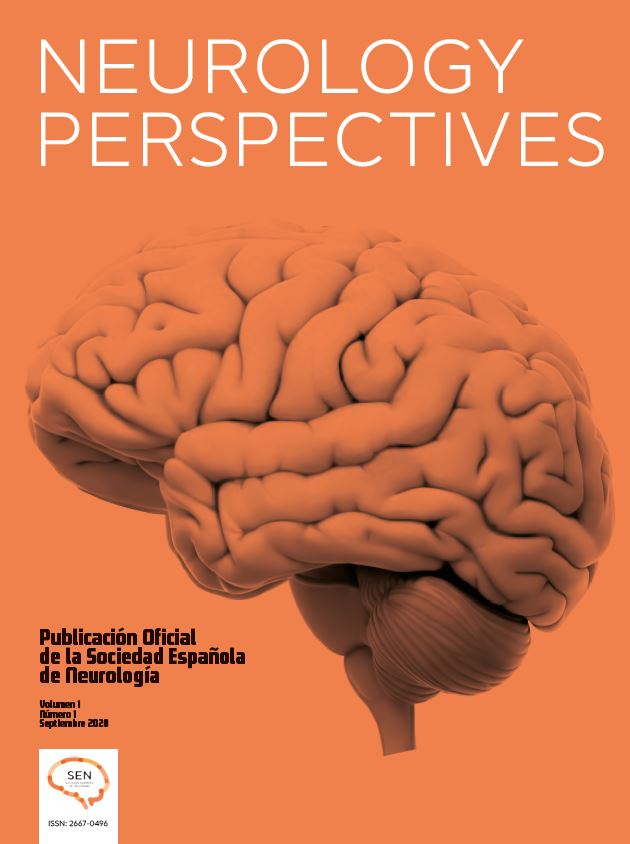Down syndrome or trisomy 21 is the most frequent cause of intellectual disability of genetic origin.1 Epilepsy is a frequent comorbidity in these patients, especially at older ages, with a prevalence of up to 46% in patients older than 50 years.2 In these cases, epilepsy manifests with myoclonic or tonic–clonic seizures and generalised polyspike-wave epileptiform activity in the electroencephalography study (EEG). Epilepsy may be accompanied by cognitive impairment with anatomopathological characteristics of Alzheimer’s disease, such as increased production of amyloid and senile plaques3; this is known as late-onset myoclonic epilepsy associated with Down syndrome (LOMEDS).1,2
Epilepsy in these patients is not necessarily refractory; in fact, the majority of cases respond to such first-line antiepileptic drugs as levetiracetam or valproic acid. Approximately, 20% of patients require second-line treatment, with perampanel being a safe and effective option.4
We present the case of a 47-year-old woman with Down syndrome with a history of surgery to treat an interatrial communication at neonatal age. Five years earlier, she presented epilepsy with myoclonic seizures, predominantly occurring in the morning and affecting the upper limbs. From that time, she had shown executive cognitive decline and language impairment, requiring assistance for activities of daily living. Seizures were initially more sporadic, but progressively became more frequent. The patient started early treatment with valproic acid dosed at up to 1000 mg daily, without achieving adequate seizure control and showing such adverse effects as weight gain, tremor, and symptomatic hyperammonaemia. Treatment was switched to levetiracetam dosed at 1500 mg every 12 h; the response was better, but seizure control was not achieved. The patient was admitted to the hospital for observation on several occasions due to recurrent respiratory infections secondary to seizure-related aspiration. Dual therapy was started with the addition of topiramate dosed at 150 mg every 12 h, which worsened the cognitive symptoms; therefore, the dose was reduced to 100 mg every 12 h, and clonazepam at 3 mg daily was added. The response to triple therapy was suboptimal: the patient presented excessive daytime sleepiness and treatment was ineffective (seizures continued to present on a weekly or daily basis). She was admitted on several occasions due to seizure clusters and on one occasion due to myoclonic status epilepticus. Initially, the patient presented refractory epilepsy, showing no response to levetiracetam, valproate, clonazepam, or topiramate. Perampanel was subsequently started, and topiramate and clonazepam were discontinued due to the cognitive worsening; sedation was also discontinued, as secretions are a vicious cycle for aspiration. Doses of 10 mg perampanel together with levetiracetam were administered, achieving 75% seizure control and an EEG improvement during status epilepticus. A CT scan revealed generalised cortical atrophy, and the EEG showed slow-wave baseline cortical activity with generalised polyspike-wave discharges (Figs. 1 and 2).
At first, the patient presented drug-resistant epilepsy and progressive and gradual worsening, with peaks especially during seizure clusters and status epilepticus. The dominant characteristic of the syndrome is myoclonic epilepsy; its onset represents a turning point in the patient's progression, leading to exacerbation of the deterioration of higher functions. However, we should bear in mind the added pharmacological effect on cognitive skills, especially with topiramate and valproic acid, with the latter being discontinued and the dose of the former decreased for this reason.
In the management of this patient, we selected first-line antiepileptic drugs for myoclonic seizures, such as levetiracetam and valproic acid, achieving an optimal result with perampanel dosed at 10 mg. We started with a dose of 2 mg daily for one week, which we were forced to rapidly uptitrate to 4 mg in the second week, and then from 6 to 10 mg, without waiting a week between dose increases, as the patient was admitted due to status epilepticus. It was at this point that seizures were controlled, and we observed improvements in the EEG recording, with no excessive daytime sleepiness.
The association between generalised epilepsy and Down syndrome at an advanced age, in line with this chromosomal disorder, represents an epiphenomenon in disease progression and causes a rapidly progressive worsening of cognitive and motor functions. Patients who are independent or partially dependent on daily living activities will eventually require supervision for self-care.5 Patients present well-defined electroclinical characteristics, and the disorder manifests as progressive myoclonic epilepsy, probably due to the structural changes that characterise the similar progression of Down syndrome and Alzheimer’s disease.
The aim of this article is to underscore the importance of considering LOMEDS in the differential diagnosis of progressive myoclonic epilepsy in adults. It is essential to identify this syndrome due to its prognostic and therapeutic implications: appropriate drugs must be selected for these patients, avoiding those that may exacerbate myoclonus and higher functions. Neurologists should be familiar with epilepsy in patients with Down syndrome, as they will require direct and indirect resources. Thanks to improvements in the health status of patients with trisomy 21, they frequently live beyond 50 years of age. Their management frequently requires the support of a multidisciplinary team including infectious disease specialists, endocrinologists, physiatrists, and neurologists.
It is equally important to acknowledge the role of perampanel as a promising antimyoclonic drug, with low doses being effective as an early add-on therapy, and not to limit its use to advanced stages of the disease when other antiepileptic drugs have failed. Future studies are needed to review the role of the drug in similar cases.
FundingNone.
The patient gave written informed consentThis study complies with the ethical considerations of the ethics committee of our hospital.









